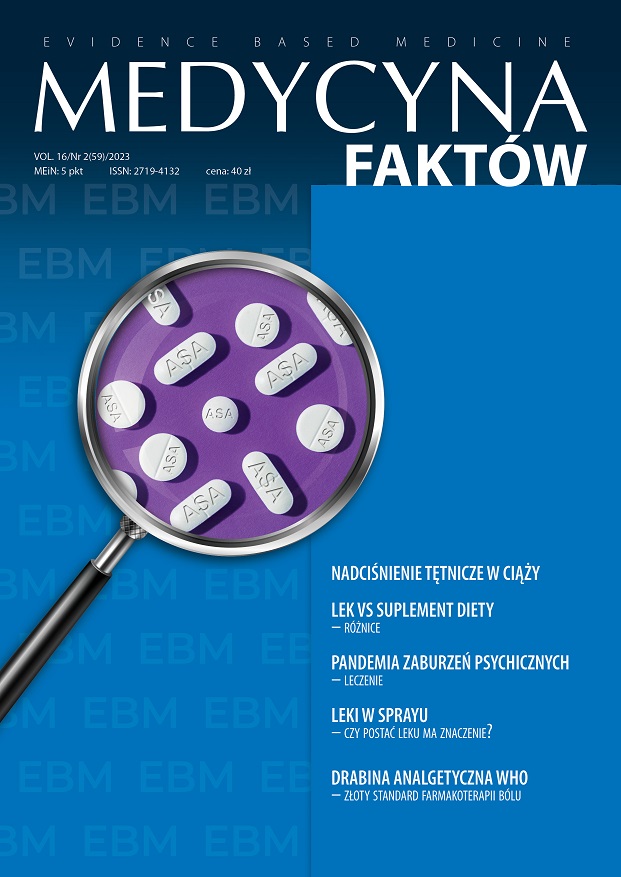Gdy nadchodzi nawałnica. Lęk, depresja, zaburzenia snu – dlaczego z pandemią zaburzeń psychicznych będą się mierzyć niepsychiatrzy? Opis przypadku
##plugins.themes.bootstrap3.article.main##
Abstrakt
Żyjemy w trudnych czasach. Pacjent z lękiem, zaburzeniami snu, objawami depresji staje się standardowym pacjentem nie tyle psychiatrów, ile lekarzy innych specjalności. Recepty na leki przeciwdepresyjne wystawiane są również przez lekarzy rodzinnych, internistów, neurologów, kardiologów oraz innych specjalistów. To pokazuje rolę edukacji lekarzy wszystkich specjalizacji w zakresie diagnostyki i leczenia zaburzeń psychicznych. W artykule zaprezentowano kilka typowych przypadków pacjentów, którzy trafiają do poradni w celu diagnostyki chorób somatycznych, podczas gdy podłoże zgłaszanych przez nich objawów jest psychiczne. W tekście skupiono się na roli doboru adekwatnej dawki leku i formy jego podania jako czynników warunkujących skuteczne leczenie oraz dobrą współpracę lekarz–pacjent.
##plugins.themes.bootstrap3.article.details##
Copyright © by Medical Education. All rights reserved.
Bibliografia
2. Gambin M, Sękowski M, Woźniak-Prus M et al. Objawy depresji i lęku wśród Polaków w trakcie epidemii COVID-19. Raport z badań podłużnych. Uniwersytet Warszawski.
3. Lubrańska A. Życie w cieniu pandemii – psychologiczne konsekwencje w sferze pracy. Horyzonty Wychowania. 2021; 20(55): 27-36. http://doi.org/10.35765/hw.2099.
4. Raina P, Wolfson C, Griffith L et al. A longitudinal analysis of the impact of the COVID-19 pandemic on the mental health of middle-aged and older adults from the Canadian Longitudinal Study on Aging. Nat Aging. 2021; 1: 1137-47.
5. Małyszczak K, Pawłowski T. Zespoły lękowo-depresyjne. Patogeneza, obraz kliniczny i leczenie. Akademia Medyczna im. Piastów Śląskich we Wrocławiu, Wrocław 2007.
6. Stein DJ, Hollander E. Współchorobowość depresji i zaburzeń lękowych. Via Medica, Gdańsk 2004.
7. Arnow BA, Blasey C, Manber R et al. Dropouts versus completers among chronically depressed outpatients. J Affect Disord. 2007; 97: 197-202.
8. Jarema M, Wichniak A. Podstawy rozpoznawanie i leczenie wybranych zaburzeń snu – Biblioteka Czasopisma „Psychiatria”. Via Medica, Gdańsk 2017.
9. Amos T, Witt EA, Alphs L et al. Poster Presented at 29th Annual US Psychiatric & Mental Health Congress, October 21–24 2016; San Antonio, USA.
10. Amos TB, Tandon N, Levebrve P et al. Direct and Indirect Cost Burden and Change of Employment Status in Treatment-Resistant Depression: A Matched-Cohort Study Using a US Commercial Claims Database. J Clin Psychiatry. 2018; 79(2): pii:17m11725. http://doi.org/10.4088/JCP.17m11725.
11. Jarema M, Dudek D, Landowski J et al. Trazodon: lek przeciwdepresyjny : mechanizm działania i miejsce w leczeniu depresji. Psychiatria Polska. 2011; 45(4), 611-25.
12. Shigemoto Y, Fujii Y, Shinomiya K et al. Participation of histaminergic H1 and noradrenergic alpha 1 receptors in orexin A-induced wakefulness in rats. Brain Res. 2004; 1023: 121-5.
13. Oberndorfer S, Saletu-Zychlarz G, Saletu B. Effects of selective serotonin reuptake inhibitors on objective and subjective sleep quality. Neuropsychobiol. 2000; 42: 69-81.
14. Le Bon O. Contribution of sleep research to the development of new antidepressants. Dialogues Clin Neurosci. 2005; 7: 305-13.
15. Landowski J. Wybór leku przeciwdepresyjnego. Dysk Depr. 2001; 10: 2-11.
16. Charakterystyka produktu leczniczego – trazodon.
